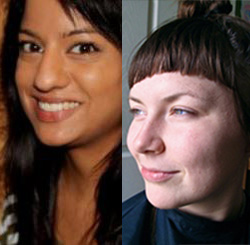
Gulnaz Saiyed

Natalia Smirnov
From The Chicago Bureau:
The American public are aware of our many gaps: The wealth gap in the U.S. is worse than in most industrialized nations; we have a skills gap, with American students falling behind the rest of the world on science and math exams; and the achievement gap between white, black and Latino students continues to be an embarrassment and driver of education reform.
Now comes the 30 million-word gap, which is gaining traction in education, research — and political circles.
According to the Clinton Foundation, the word gap is too big to ignore and “too small to fail.” This gap — also known as “language gap” or “vocabulary gap” — is based on a two-decades-old research finding that children from “welfare” families were exposed to an average of 30 million fewer words than children from high-income families during their first four years.
 Education reformers and policymakers have mobilized to close the 30 million-word gap, convinced that parents should have more conversations with their children in order to head off the deficits in schooling and income that persist for the poor and minorities as they grow up.
Education reformers and policymakers have mobilized to close the 30 million-word gap, convinced that parents should have more conversations with their children in order to head off the deficits in schooling and income that persist for the poor and minorities as they grow up.
This, in turn, has spurred large-scale university-led interventions such as the University of Chicago-based “Thirty Million Words Initiative” to get parents to talk more to their kids.
Meanwhile, Hillary Clinton has fastened on the word gap as a key education reform plank in her expected run for the presidency in 2016. “Coming to school without words is like coming to school without food or adequate health care,” she wrote in an October 2014 Clinton Foundation commentary.
But pinning the differences in school achievement and adult income on the number of words heard by the age of 3 is overly narrow and strategically unsound.
The word gap rhetoric plays on the pair of values dear to the American ethos: diversity and meritocracy — the idea that anyone, no matter his or her background, can be successful. However, by presenting white and wealthy parenting practices as a singular pathway to success, the Word Gap movement essentially casts our supposedly valued diversity as a deficit.
This latest “big idea” isn’t new. It was spawned in 1995 when two researchers at the University of Kansas, Betty Hart and Todd Risley, observed parents interacting with their child for one hour a month for 2 1/2 years, then multiplied their data to account for the times they weren’t around. Let’s see what’s wrong with their research and this newest solution to America’s problems.
First, arithmetic sleight-of-hand. If 30 million words sounds far too big a difference, that’s because it is. This number was calculated by comparing the parent and child talk word output of six African-American welfare families against 13 — that’s 13 — upper-middle class and mostly white families.
Second, ethnic and cultural bias. They didn’t include Latinos, Asians and nontraditional family configurations.
And third, skimpy observations. Their study didn’t include words and sounds heard during play among siblings or overheard from adult talking or nonverbal communication.
No wonder the 30 million-word disparity.
But despite the limits of this original study, other researchers readily tied the word gap to children’s brain development and early literacy skills, rhetorically linking the school-based achievement gap to differences in language exposure that begin before children even start school.
Politicians have added their voices. In an online post Clinton said of the word gap that it “leads to further disparities in achievement and success over time, from academic performance and persistence to earnings and family stability even 20 and 30 years later.”
We support the Clinton Foundation and other similar organizations’ focus on early learning and low-income families. However, the strategy of intervening into parents’ vocabulary and speech patterns in particular is being presented as a cure-all for much greater systemic inequalities.
Missing from Clinton’s pipeline-to-adult failure argument are institutional disadvantages that parents don’t control, such as inequitable school funding, biases in standardized tests and the effort spent to navigate life in poverty while wealthier families cultivate internship opportunities and academic tutoring for their children.
In effect, the word gap interventions propose that improving social and economic outcomes for poor and minority families can be as simple as training them to act more white and middle-class (and monitoring their compliance with a “word pedometer”). Policymakers and researchers suggest that parents who don’t talk with their children this way are missing out on a simple, easy, obvious and research-supported method for success.
But a long tradition of learning sciences research complicates that claim. Consider: What if we assumed that all parents, whatever their background, want the best for their kids and are making different choices for their children given their own circumstances? Studies show that Chinese- American mothers use approaches that socialize children into cultural values of family and community.
This includes teaching children to observe more than talk. And some African-American parents raise their boys not to talk too much, because this might be perceived as disruptive in schools. So while Hart and Risley found that some children hear fewer words than others, they did not ask why that might be the case.
The two also suggest that students who hear more words enter kindergarten with larger vocabularies, which in turn helps them succeed in school. But they only measure the children’s knowledge of Standard English, using the culturally biased Peabody Vocabulary test.
Further, other research shows that a reason middle-class children do better in school on average is because typical middle-class parenting includes verbal interactions that mirror what children hear in school (“What does the cow say?” “Moo-moo!” “Yes, that’s right!”). Some children are simply not raised with adults asking them questions with obvious answers.
While middle-class activities do lead children to develop a sense of entitlement, individuality and set them up to feel comfortable in schools, they de-emphasize other childhood experiences. For example, many working-class parents do not overschedule their children with extracurricular activities. Instead, they provide opportunities for play, development of curiosity, creativity and respect for different perspectives.
These are qualities we know are important for an innovative economy.
Additionally, children from different backgrounds come to school with different skill sets. Bilingual students have been shown to outperform their monolingual peers on measures of self-control, and bilingualism has long-term cognitive, social and socioemotional benefits. Children who speak African American English Vernacular (AAEV) have a rich and deep understanding of language and wordplay, which can be used in classrooms as a bridge to academic literary analysis.
The examples above illustrate that differences are not deficits. Culturally diverse environments often provide children with richly diverse social and cognitive toolkits, which should be developed and expanded upon in school. This is because we know they are valuable in the real world. Examples of culturally relevant education are shown to lead to positive academic and social outcomes. But, there is no study directly linking vocabulary size to long-term school achievement.
The writers of the Clinton Foundation report, “Too Small to Fail,” argue that the poverty of vocabulary should be discussed with the same passion as child hunger. They say we should be outraged and moved to action by the parents who fail to feed their children with words.
We say that a focus on early vocabulary exposure as the key and mitigating factor that produces different long-term outcomes between children is narrow and unproductive.
To be sure, we should enact research-based policies to support parents to feed their children with words, with experiences, with skills and knowledge. But spending our money promoting just one (white, middle class) way of doing that, and just in the first few years of a child’s life, is nearsighted and cripples diversity.
We should instead focus our resources on culturally relevant programs that build a broad range of literacy, cognitive and social skills over time, and not just limited to early childhood. These could include vocabulary interventions, but they should not be limited to them if we genuinely believe in building an egalitarian, pluralistic society in which we make the most of human potential — including individual and cultural differences — to feed conversation, creativity and innovation.
This article originally appeared in The Chicago Bureau.
Gulnaz Saiyed and Natalia Smirnov are doctoral candidates in the Learning Sciences Group at Northwestern University’s School of Education and Social Policy.
The following members of the Diversity in Learning Sciences Group at Northwestern University helped research this article: Alki Antonopoulou, Dionne Champion, Amy Chang, Janene Cielto, Ruben Echevarria, Courtney Mays, Kristen McCarthy, Douglas L. Medin, Phoebe Pahng and Y’Shanda Rivera.

























